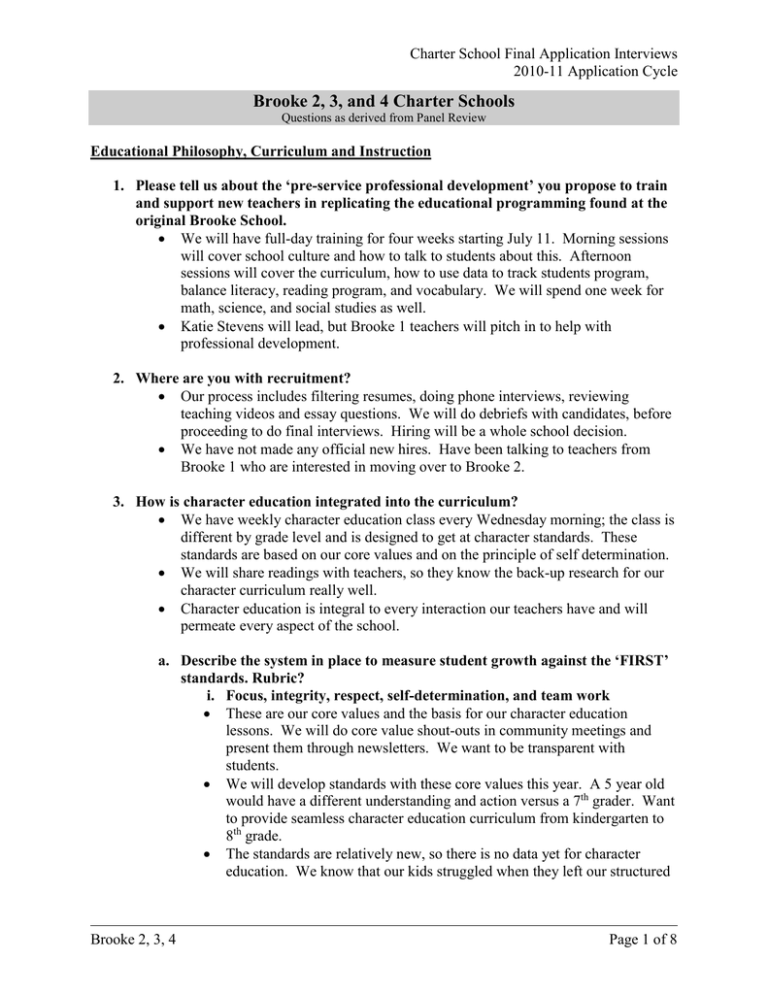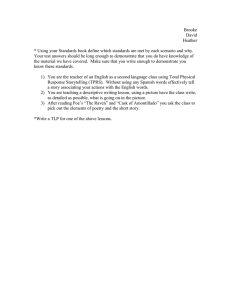item2 ewbcs interview
advertisement

Charter School Final Application Interviews 2010-11 Application Cycle Brooke 2, 3, and 4 Charter Schools Questions as derived from Panel Review Educational Philosophy, Curriculum and Instruction 1. Please tell us about the ‘pre-service professional development’ you propose to train and support new teachers in replicating the educational programming found at the original Brooke School. We will have full-day training for four weeks starting July 11. Morning sessions will cover school culture and how to talk to students about this. Afternoon sessions will cover the curriculum, how to use data to track students program, balance literacy, reading program, and vocabulary. We will spend one week for math, science, and social studies as well. Katie Stevens will lead, but Brooke 1 teachers will pitch in to help with professional development. 2. Where are you with recruitment? Our process includes filtering resumes, doing phone interviews, reviewing teaching videos and essay questions. We will do debriefs with candidates, before proceeding to do final interviews. Hiring will be a whole school decision. We have not made any official new hires. Have been talking to teachers from Brooke 1 who are interested in moving over to Brooke 2. 3. How is character education integrated into the curriculum? We have weekly character education class every Wednesday morning; the class is different by grade level and is designed to get at character standards. These standards are based on our core values and on the principle of self determination. We will share readings with teachers, so they know the back-up research for our character curriculum really well. Character education is integral to every interaction our teachers have and will permeate every aspect of the school. a. Describe the system in place to measure student growth against the ‘FIRST’ standards. Rubric? i. Focus, integrity, respect, self-determination, and team work These are our core values and the basis for our character education lessons. We will do core value shout-outs in community meetings and present them through newsletters. We want to be transparent with students. We will develop standards with these core values this year. A 5 year old would have a different understanding and action versus a 7th grader. Want to provide seamless character education curriculum from kindergarten to 8th grade. The standards are relatively new, so there is no data yet for character education. We know that our kids struggled when they left our structured Brooke 2, 3, 4 Page 1 of 8 Charter School Final Application Interviews 2010-11 Application Cycle environment, so this is impetus for stepping up our character education program. b. How are students and parents informed about FIRST progress? We have this on the report card, but in very general terms. We haven’t tracked over time how kids are doing, partially because our expectations of kids are rising every year as well. Want to figure out a way to measure character education progress along the way. Teachers keep in contact with parents about student’s growth, whether it’s positive or negative. Assessment, Promotion, and Graduation Standards 1. How will the Co-Director for Academics develop and coordinate the network wide assessments? Our assessment right now is based on the MCAS. We use comparisons from previous students, district data, and data from top performing schools. Our standards are designed to align to the MCAS and to go beyond. We can use these assessments for all our schools and compare them. Will need to figure out how to measure achievement with new students though. 2. There appears to be a homework completion rate on the report card. Is homework completion or performance part of the student’s grade? Is it part of promotion? In the middle school grades, the homework completion rate is reported separate from the standard grade. It does show up on the report card and will go to the high school students apply to. The grade is about mastery of standard, while the homework completion rate informs work habit. For younger grades, kids have to stay after school to finish homework. For anyone without English speaking parents at home, we have homework help after school for them too. By third grade, we do expect all students to do homework independently. For higher elementary grades, students get privileges if they do everything they’re supposed to do. There are punitive measures if they don’t; for example, not being able to go on field trips. 3. What academic supports are available for students who receive notice at the end of the 2nd trimester that they may be retained? There are different criteria. First, we look for standards mastery. If the student has a 2.4 or below average, it’s a red light for us. We would then speak with the parents about tutoring options before or after school. Second, we look at the practice MCAS assessment. a. How and when do students develop action plans? We set goals based on the MCAS average. Brooke 2, 3, 4 Page 2 of 8 Charter School Final Application Interviews 2010-11 Application Cycle Before this point, parents will have known that this process is happening for all kids in danger of retention. Buses drop off at 7:15 am and classes start at 7:45. This period allows for individual tutoring to take place. Our workshop model in reading and writing also allows us to give daily individual support to kids during the day. Every Wednesday, we have a math center and time for independent work. Teachers can pull kids to work on specific standards. Systems in place for kids who need it. Our small class size helps with the ability to work with students individually. We also have associate teachers in the classroom to help with instructions. We also have the flexibility of having the student support teach would be working with children in the room as well. 4. What are the retention numbers for the original Brooke? On average, it’s around 5%. With incoming 5th graders, it’s always higher because they’re new to the schools and have a lot of catching up to do; probably around 10 to 15% for them. By 7th and 8th grades, we retain one kid on average. Most retained students do stay with the school – around 80%. It’s hard to keep the 8th graders, because they have high school options elsewhere. The objective at our school is to catch underperforming students early. Our goal is to have retained students stay at the school too. Our model provides for a lot of individual attention. There’s a lot of time to work one-on-one and not allow kids to get left behind. The board receives reports on growth and how each grade is progressing. There’s transparency throughout the process. School Characteristics 1. Explain the afterschool programming provided to students. a. Is the programming fee-based? For young kids, it is fee-based because it is basically daycare. Our associate teachers and alumni oversee the play area and run a homework center. Tutoring, homework completion, and detention services are not fee based. Detention is from 4 to 5:30pm; the dean of students would call parents to alert them. For middle school, there is a mandated homework time. Jon Clark stays until 7pm sometimes to supervise mandated homework time. For tutoring not related to homework completion, the teacher figures out with parents when the tutoring will happen. Our teacher does tutoring for their own kids. We have one teacher who drives students home. Brooke 2, 3, 4 Page 3 of 8 Charter School Final Application Interviews 2010-11 Application Cycle 2. Beyond classroom management – how will each school’s culture be developed and maintained? At Brooke 2, we want to keep much of the core values the same. Want to see the dean of students leading community meetings, teaching character education classes, and getting students excited about core values. 3. What systems do you have in place or plan to implement to specifically measure the success of your college preparatory mission? Starting with 3rd grade, there will be opportunities for students to visit college campuses. The homeroom will be named after the alma mater of the lead teacher. Starting in 7th grade, we’ll have students work with the high school placement department and graduate student services. In graduate student services, we have a dedicated director supporting 160 students spread across 10 high schools. We try our best to leverage the high school support they already have within their schools. We’ll leverage partnerships and make the connections to support our students. Will connect them with summer opportunities. Will target community partners to extend and leverage our mission. We see ourselves as brokering resources for our alumni. Special Student Populations and Services 1. What do you think are the needs of the English language learner (ELL) population you hope to serve in Chelsea and Boston? They need to learn English. We need to teach them English. We will need parents’ buy-in by providing information to them in their home language. Want to welcome parents in the school. a. How will your strategies meet the needs of ELLs? If you teach all students well, our literacy workshop model allows time for individualized direct work and instructions. Kids need a lot of time to read and to speak. Some students need explicit phonics instruction. We have a lot of time in the day that allows for individualized work – we can work with that and be flexible with the time. When parents come in to the school, we would have translators for them, or we would use liaisons to help with communications. b. What instructional “best practices” strategies have you identified for English language learners? individualized direct instructions building vocabulary; deal with vocabulary and phonics issues – looks different depending how old they are teachers are accountable, and give individualized attention set of compliance mandated giving them wait time, comfortable making mistakes, warm culture will give them structured English instructions, depending on skills level Brooke 2, 3, 4 Page 4 of 8 Charter School Final Application Interviews 2010-11 Application Cycle will give sheltered English support in the rest of the day will have teachers who will do whatever it takes for their students c. How will you provide SEI category training for teachers? We’re making sure we are getting enough training right now. Our plan is to have category 2 training now. Want to get all our teachers across the network to get training in this. We’ll be able to provide better training for a network of schools, because we can bring in a high quality trainer. 2. Please describe the proposed staffing to implement both ESL and special education programming. How flexible are you with staffing in order to meet the needs of your students? We understand we will have to be flexible. We budgeted conservatively year to year, so that we can make decisions to move staff around. We make conservative assumptions about what kind of funding we’ll get from the state. We have been able to accumulate some savings. We’re in a good financial position. On the accounting side, we have always been able to get an unqualified audit. The goal of excellent teaching goes right into the budget. We would minimize facilities costs, so we can provide the most resources to teaching. 3. When do English and Student Support teachers collaborate with general education teachers? We would make sure they have preparation time at the same time every day, while the kids are at co-curricular activities. On Wednesday afternoons, we would also have formal time to co-plan. 4. How does your existing school staff the school nurse position? a. PT nurse proposed through 5 years: are they shared around the network? We have a PT nurse right now. We plan to have a shared PT nurse among the network. Governance and Management 1. Please explain what board members perceive as the benefits of creating a network of schools. There’s a particular culture at Brooke and processes for making teaching the center of attention. Having a network would help to strip away the administrative trivia and allow the organization to grow from within. Our approach to general education is very particular and detailed. With English Language Learners and Special Education, we will develop our own views and expertise about the best way to teach this population of students. Having a network would help to leverage resources to do this. Having a network would allow us to focus on human capital capacity. We’ll have economies of scale and of knowledge. You can share what you know is working. You can get well-trained people to focus on these issues. Brooke 2, 3, 4 Page 5 of 8 Charter School Final Application Interviews 2010-11 Application Cycle 2. What challenges do board members anticipate in overseeing the proposed network of four schools? How have their experiences prepared them to address these challenges? Human resources is a challenge; it's a challenge to find great teachers. We have an associate teacher program to help with this challenge. As we continue to grow, we need to find teachers and provide them with professional development. We need to find school leaders, principals and assistant principals and have them to permeate the culture. Finding facilities, a building, is another challenge. Our board has the experience and capability to do the financing and all that. We have more real estate development expertise now on board as well. Calibration is also a challenge. With new students coming into the schools, how will we gauge students’ level and how will we judge the performance of staff and students. Based on the Brooke 1 experience, we have made our mistakes, and now we have a system we want to replicate. We know what success looks like. We have a successful model, but replicating the model might require more time than we think. Might need to put in more board time. We believe in taking as much time as you need to get the process right. There will be challenges we won’t be anticipating. 3. What structural or procedural changes does the board of trustees anticipate making in order to effectively manage this proposed network of schools? We already look at dashboard reports for a single school, so we can do this across multiple schools. This structure is expandable to look at performance across the network. We also have co-directors of the network who will have relationships with codirectors at each school. So there will be a structure for information to flow upward. a. Will quarterly meetings be enough for start-up? Used to meet monthly. Moved to quarterly recently. We’re growing the board. We have trainings for the board. We do a lot of committee work. It’s more effective to do work in committees because people have expertise. Have more internal resources, such as a Chief Operating Officer, a Director of Development and a Controller to work with the board. We’ll adjust the board schedule as we go along. We have an advisory board now. A lot of capacity was added to the network in advance of being granted the charter. It’s been a great advantage for us to prepare for charter expansion. 4. Please describe the leadership team at the network level. Central office staff, including Kimberly and Jon, are at the network level. We structured it so that in the very first year they will be at the network level. Brooke 2, 3, 4 Page 6 of 8 Charter School Final Application Interviews 2010-11 Application Cycle Kimberly and Jon, being both founders, will be looking at quality issues across the programs and schools. Scott Knox will be the other member of this network team. a. Who is the Chief Operating Officer? Who is the Director of External Affairs? Scott Knox is the COO. The Director of External affairs has traditional development work experience and is spreading word about what we do. This staff will step up at the network level too. We want to be a data point in how to close the achievement gap. We want to impact our families, but also to impact other school models. b. Explain how the Director of Student Support (Special Education) and the Director of ELL will support staff at the school level. They will be at the network level to deal with compliance issues. There will be a supervisor for special education and ELL support across all schools. Their role is more administrative rather than teaching. They will provide training and supervision in a coaching role. 5. Have candidates been identified to fill the principal positions at the original Brooke and the proposed schools? For Brooke 3 and 4, we have internal candidates to consider. Katie helped build the culture at Brooke 1 and she has been there since the first day. She will be able to bring the same kind of high quality work to Brooke 2. We developed an Instructional Fellowship to develop hands-on experience for school leadership. These fellows help to develop professional development trainings and they meet with Kimberly every day. They do the hiring and are managing that process. In addition to teaching a full load this year, the fellows will be performing all these other support functions. The idea is to let them understand how to juggle different priorities. 6. Please describe your performance-based bonus program. Great teaching is the special sauce. Our teacher salaries are lower than BPS. We have been a recipient of a federal grant, allowing us to provide up to $10,000 performance based bonuses. This is a way for us to provide recognition and to emphasize that great teaching is the key. Performance-based bonus is both school based and individual based. We assess based on scientific data and on the growth of students. It is for going beyond expectations, which is a solid performance. For co-directors, the bonus is based on students’ MCAS performance. Bonuses are not guaranteed. Brooke 2, 3, 4 Page 7 of 8 Charter School Final Application Interviews 2010-11 Application Cycle Budget 1. Please clarify how the money will flow through the network. There are not a lot of models across the country, since this law is new. We came up with a plan for one board to hold multiple charters. The question is do we start a CMO and have a separate board? This would be too complicated for us; and we wanted more simplicity and transparency. We looked into Mastery Schools in Pennsylvania. They love the model of one board holding multiple charters. It’s good to have someone else doing this telling us that it works out in practice. a. Will the original Brooke pay the bill and send a bill to the other schools? For now, network expenses would be on the books of the original school. Original school then bills to the other schools the proportion of enrollment. b. Does the network management fee include testing and assessment costs? i. line item 39 is zero and item 43 is entirely special education instructional services Testing and assessment is managed by the principals and created by instructional leaders. Our analysis work is Excel based, so it’s internal and ready to go. For special testings, we will contract out. c. Why are there no purchased management fees allocated for the network under ‘other student services’ or ‘plant operation and maintenance’? (only administrative and instructional services) This is an accounting issue. Facilities management is going to be local and school-based. Brooke 2, 3, 4 Page 8 of 8



